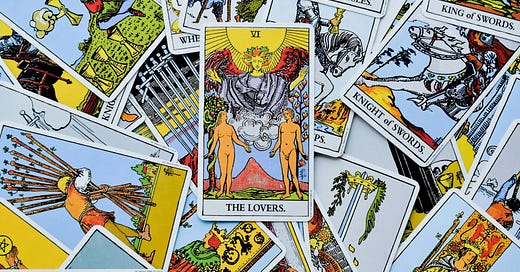If you communicate in a way that others don’t understand, a typical response is for them to think you are stupid.
Visceral, often disproportionate, reactions are common for things we don’t understand (although the quiet part usually isn’t said out loud.) It is much easier to simplify, ignore the nuance, and resort to tropes; the anima behind the Salem witch trials embodied this.
Tarot seems to be a bit of a bogeyman. Deriding it suggests a fear bubbling under the surface—a fear of the unknown.
The trope of seeing a decrepit, miscreant tarot reader stumble upon the “Death” or “The Tower” card—oh, the horror1—and predict ruin for the protagonist, as well as other tropes, don’t seem to have fully run their course in popular media.
Seeing the advertisement for the film, Tarot, prompted me to write this article.
The poster states: “Your fate is in the cards,” and centres around the cards containing evil powers; how original. “I was The Fool for going to see this,” an IMDb user titled their review, aptly representing the trope-filled film.
On the face of it, tarot cards are merely images on cards—which is true. Yet, a dismissive first glance does not do justice to the breadth and depth the images can convey. “An image can present a very large number of ideas at once, in comparison to the more restricted bandwidth of language,” writes Jordan Peterson in his book, We Who Wrestle With God.
Amber Khan, a well-known tarot reader, demystifies tarot in her typical succinct and insightful manner2:
“The thing about Jungian tarot that’s so gratifying is that it’s a map of your mind. It’s not trying to tell you what’s going to happen, it’s telling you where you’re at. So you can make a very informed decision about what happens next. You get to hold onto your free will, which is really important. . .
Jungian tarot is about your back brain talking to your front brain. It’s a set of symbols on cards that talk to the part of your brain that speaks in symbols, that you can’t directly communicate with. So, this is a conversation, this is psychological—it’s not predictive, it’s a conversation between you and you.”
A tarot reading could be viewed like a Rorschach test where you are the patient and practitioner. “Could the patient interpret his own projections upon the ink-blot, he would have some useful information about himself for the guidance of his future conduct,” writes Alan Watts, in his book, The Way of Zen.
Tapping into different aspects of yourself and using this insight to attempt to understand yourself and others better; then using this information and your free will to aim to improve things and operate more consciously—how terrifying; “Burn the witch!”
Yu-Gi-Oh!3 and Pokémon card fans may adore the deep symbology, lore, and visuals in tarot. Explore the Thoth Tarot deck; you’ll be engrossed for years. It may even be an entry point into the world of myth, which arguably we need more than ever since “God is dead.”
And in some ways, it’s probably more socially acceptable to read tarot than cling to your rose-tinted youth through the aforementioned cards. (No judgment if you do, by the way. I don’t make society’s rules. Why can’t adults get out their Blue Eyes White Dragons and duel without eyebrows being raised?)
The Death card doesn’t just represent literal death; it can represent other things, such as a major transformation. The Tower card can highlight the clearing of obstacles and the renewal that chaos can bring.
Others, such as Benebell Wen in her book Holistic Tarot, agree with Amber’s interpretation. However, many do believe in the divinatory powers of the tarot. I don’t necessarily think either framework is inherently ‘right’ or ‘wrong.’ Part of the reason for writing this article was to highlight the former approach, as some may resonate more with it, and therefore, may be less spooked and derogatory towards tarot. It’s up to the practitioner to discover which mindset or framing resonates most with them.
One decision that irks me to this day is selling my extensive set of Yu-Gi-Oh! cards at a car boot sale for £5 as a child. (Mo’ money, mo’ problems, I guess.)






